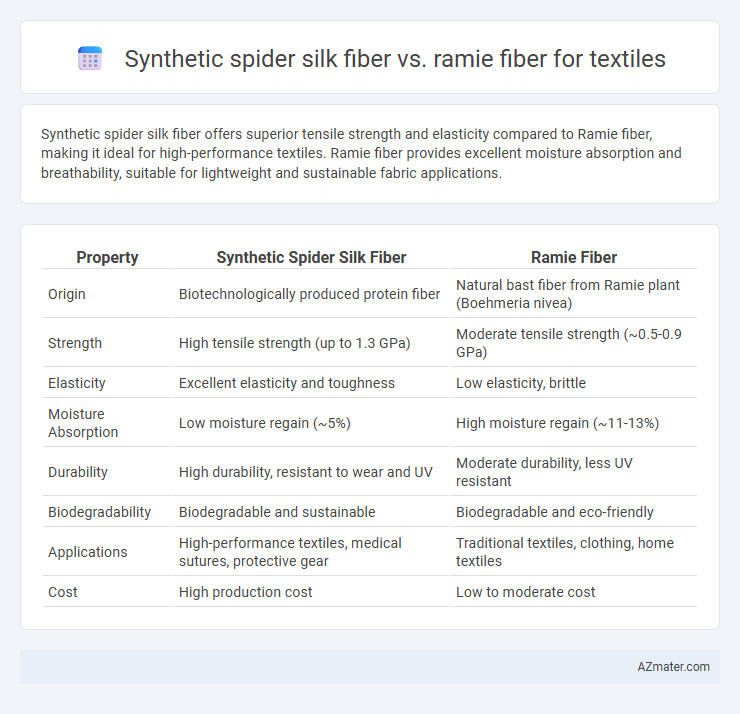Synthetic spider silk fiber offers superior tensile strength and elasticity compared to Ramie fiber, making it ideal for high-performance textiles. Ramie fiber provides excellent moisture absorption and breathability, suitable for lightweight and sustainable fabric applications.
Table of Comparison
| Property | Synthetic Spider Silk Fiber | Ramie Fiber |
|---|---|---|
| Origin | Biotechnologically produced protein fiber | Natural bast fiber from Ramie plant (Boehmeria nivea) |
| Strength | High tensile strength (up to 1.3 GPa) | Moderate tensile strength (~0.5-0.9 GPa) |
| Elasticity | Excellent elasticity and toughness | Low elasticity, brittle |
| Moisture Absorption | Low moisture regain (~5%) | High moisture regain (~11-13%) |
| Durability | High durability, resistant to wear and UV | Moderate durability, less UV resistant |
| Biodegradability | Biodegradable and sustainable | Biodegradable and eco-friendly |
| Applications | High-performance textiles, medical sutures, protective gear | Traditional textiles, clothing, home textiles |
| Cost | High production cost | Low to moderate cost |
Introduction to Synthetic Spider Silk and Ramie Fibers
Synthetic spider silk fiber, engineered from recombinant proteins, offers exceptional tensile strength, elasticity, and biodegradability, making it a revolutionary material for textile applications that demand durability and lightweight performance. Ramie fiber, derived from the stalks of the Boehmeria plant, is a natural cellulose fiber known for its luster, moisture absorption, and breathability, commonly used to enhance fabric texture and comfort. Both fibers present sustainable alternatives in textiles, with synthetic spider silk advancing high-performance wearables and ramie supporting eco-friendly, traditional fabric blends.
Origin and Production Methods
Synthetic spider silk fiber is produced through bioengineering techniques that replicate the natural proteins found in spider silk, using genetically modified organisms or fermentation processes to achieve scalable production. Ramie fiber originates from the stalks of the Boehmeria nivea plant, where the fibers are extracted through retting, followed by degumming to remove gums and impurities. While synthetic spider silk offers high tensile strength and elasticity through controlled laboratory synthesis, ramie fiber relies on traditional agricultural cultivation and mechanical processing methods.
Molecular Structure Comparison
Synthetic spider silk fiber exhibits a highly organized molecular structure dominated by repetitive protein sequences forming b-sheet nanocrystals that provide exceptional tensile strength and elasticity. Ramie fiber, a natural bast fiber, primarily consists of cellulose molecules arranged in crystalline microfibrils, contributing to its rigidity and moisture absorption capabilities. The molecular contrast between protein-based synthetic spider silk and cellulose-based ramie underpins their distinct mechanical properties and functional applications in textiles.
Mechanical Strength and Durability
Synthetic spider silk fiber exhibits superior mechanical strength compared to ramie fiber, boasting tensile strength up to 1.2 GPa versus ramie's typical 300 MPa. The elasticity and toughness of synthetic spider silk enhance durability, allowing it to withstand repeated stress without significant degradation. Ramie fiber, while naturally strong, is more prone to brittleness and environmental damage, making synthetic spider silk a more resilient choice for high-performance textile applications.
Flexibility and Elasticity
Synthetic spider silk fiber exhibits superior flexibility and elasticity compared to ramie fiber, making it highly suitable for dynamic textile applications that require stretch and resilience. Its molecular structure allows it to stretch up to 40% of its original length without breaking, while ramie fiber, a natural bast fiber, offers limited elasticity and tends to be more rigid and brittle under stress. This enhanced flexibility and elasticity of synthetic spider silk contribute to improved comfort, durability, and performance in activewear and high-performance fabrics.
Environmental Impact and Sustainability
Synthetic spider silk fiber exhibits a significantly lower environmental footprint compared to ramie fiber due to its bioengineered production, which requires less land and water resources and generates minimal agricultural runoff. Ramie fiber, derived from the stalks of the ramie plant, involves intensive pesticide use and energy consumption in fiber extraction and processing, contributing to soil degradation and pollution. The scalability of synthetic spider silk through microbial fermentation offers a sustainable alternative with reduced greenhouse gas emissions and enhanced biodegradability, aligning with circular economy principles in the textile industry.
Applications in the Textile Industry
Synthetic spider silk fiber exhibits exceptional tensile strength, elasticity, and biodegradability, making it ideal for high-performance textiles such as activewear, medical sutures, and protective clothing. Ramie fiber offers excellent moisture absorption, durability, and a silky luster, commonly used in lightweight fabrics, upholstery, and blended textiles for breathable summer wear. The textile industry leverages synthetic spider silk for innovation in smart fabrics, while ramie remains preferred for eco-friendly, affordable, and aesthetically pleasing natural fiber products.
Cost and Commercial Availability
Synthetic spider silk fiber offers superior tensile strength and elasticity compared to traditional natural fibers, but its high production costs limit large-scale commercial availability. Ramie fiber, derived from the stalks of the Boehmeria plant, is widely accessible and cost-effective, making it a popular choice for affordable textile manufacturing. Textile industries balance between synthetic spider silk's premium performance properties and ramie's economic viability and abundant supply in commercial applications.
Comfort and Aesthetic Properties
Synthetic spider silk fiber offers superior comfort due to its exceptional softness, moisture-wicking ability, and elasticity, closely mimicking natural spider silk properties. Ramie fiber, while durable and lustrous with a smooth surface, often feels coarser and less breathable, which may reduce overall comfort in textiles. Aesthetically, synthetic spider silk provides a sleek, shiny finish with excellent drape and color retention, whereas ramie delivers a natural sheen and crisp texture but tends to wrinkle easily and lose luster after washing.
Future Prospects and Innovation
Synthetic spider silk fiber exhibits superior tensile strength and elasticity compared to ramie fiber, enabling advanced applications in high-performance textiles. Innovations in bioengineering and scalable production methods are driving the commercial feasibility of synthetic spider silk, positioning it as a sustainable alternative to traditional natural fibers. Future prospects emphasize enhanced durability, biodegradability, and multifunctional textile integration, outpacing the limitations of ramie fiber in eco-friendly and smart fabric development.

Infographic: Synthetic spider silk fiber vs Ramie fiber for Textile
 azmater.com
azmater.com